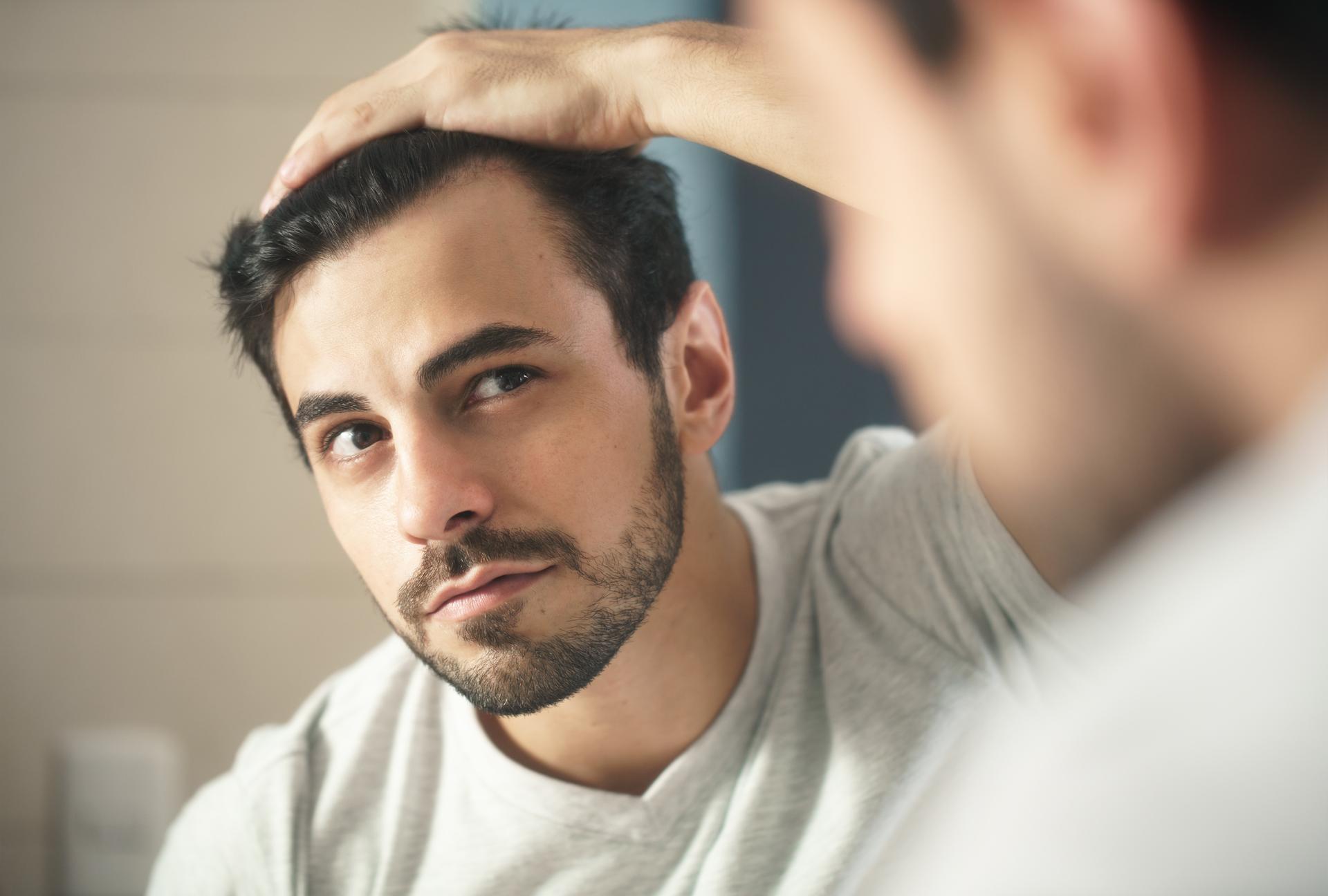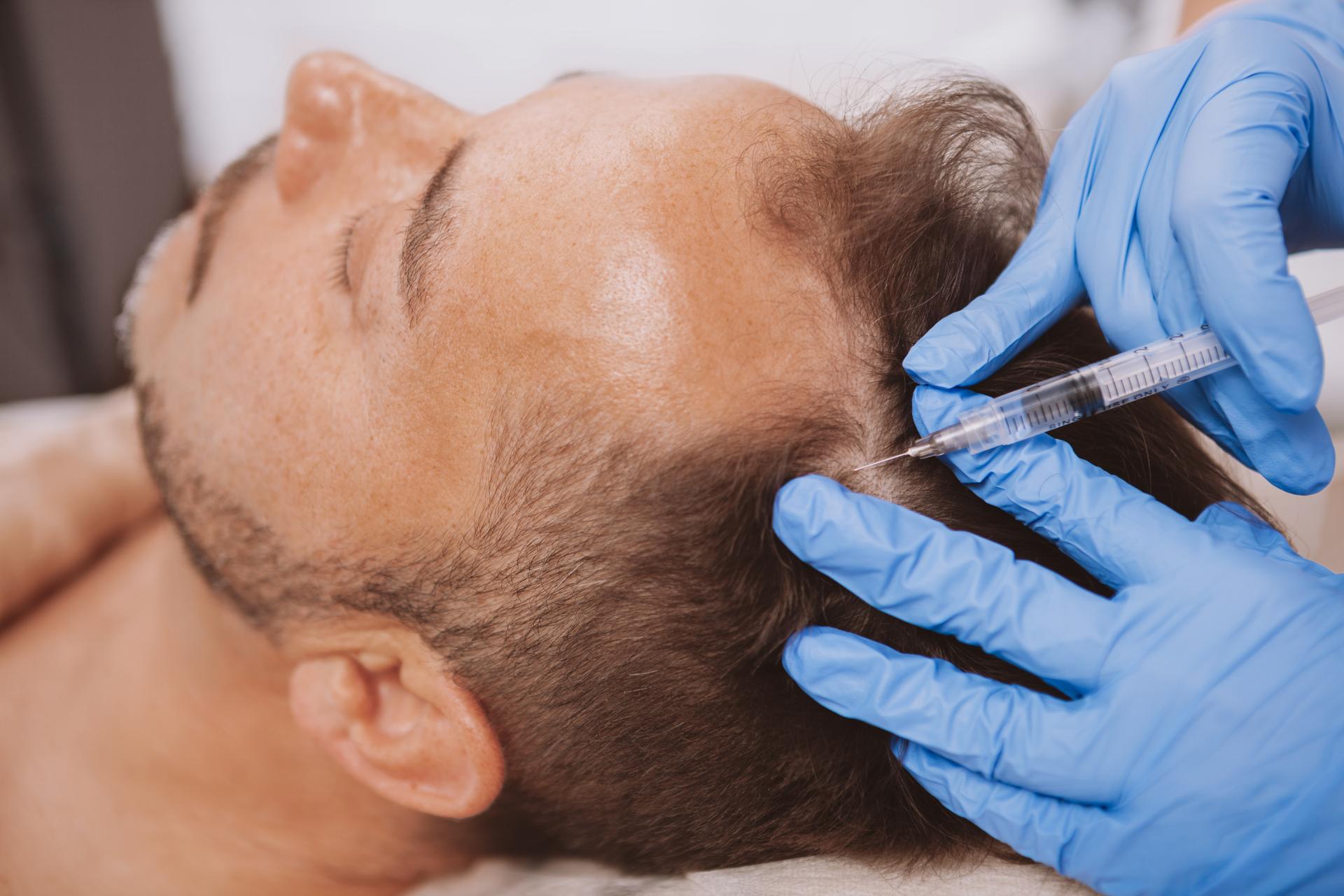The outlook continues to improve for patients seeking non-surgical hair loss treatment, thanks to continued refinements in clinic-grade solutions like minoxidil and finasteride.
Especially when integrated into a combined approach, these evidence-based therapies can dramatically slow hair loss and stimulate hair regrowth over time.
In this guide to minoxidil and finasteride for hair loss prevention, we will cover how each treatment works, what you can expect at different benchmarks throughout your treatment plan, and more.
When you’re ready to experience the transformative difference that a medically supervised hair loss treatment plan can make, our physician-led team at New Jersey Hair Restoration Center is here to make it happen.
How Do Minoxidil and Finasteride Work?
About 50 years ago, minoxidil was first introduced as a powerful hypertension (high blood pressure) treatment for patients who responded poorly to other medications. It wasn’t long before the hair loss prevention potential of minoxidil was discovered, and topical versions of the drug were prepared for both men and (eventually) women.
Minoxidil for Hair Loss Prevention
The exact mechanisms by which minoxidil treats hair loss are still being explored and debated, but the following factors have been revealed as contributors to its hair loss treatment potential:
- Circulation – Minoxidil improves blood supply to hair follicles and the scalp by widening blood vessels.
- Vascularization – Compounding on the benefits of improved circulation, minoxidil is believed to enhance the activity of certain growth factors which can create new blood vessels around hair follicles.
- Enzyme interactions – Minoxidil activates enzymes (like prostaglandin-endoperoxide synthase-1) that regulate the hair growth cycle.
Other proposed mechanisms include decreasing androgen sensitivity, prolonging the anagen (growth) phase, and promoting collagen activity.
A Crash Course On Finasteride
Finasteride is an FDA-approved hair loss medication that, like minoxidil, was originally developed to treat something other than hair loss. Just a few years after its initial use in the early 1990s as a treatment for benign prostatic hyperplasia, finasteride was approved to treat male pattern baldness.
Also known as androgenetic alopecia, male pattern baldness is characterized by an abnormal reaction of the hair follicles to a hormone called dihydrotestosterone, or DHT. When exposed to DHT, the hair follicle shrinks, resulting in thinning of hair and eventual hair loss.
Finasteride significantly reduces the amount of circulating DHT by impeding the body’s ability to derive it from testosterone. Even when successful, finasteride does not eliminate all DHT, which is one reason why this hair loss medication can take several months to show results. Still, many patients have seen a reversal of hair loss with consistent finasteride treatment.
Minoxidil and Finasteride Results: What, When, and Where
While both of these hair loss treatments tend to yield their full results within several months, each is associated with a unique process, including unique post-treatment effects. Knowing what to look for and when to look for it in each case can help you make critical decisions as it concerns the plan moving forward.
Minoxidil Results Timeline
Months 1-3: Especially to the uninitiated, the first several weeks or months after starting a minoxidil regimen may come as a shock. Don’t be concerned; increased hair loss is actually expected. Usually referred to as shedding, accelerated hair loss means the scalp is responding to the treatment, and the follicles are transitioning into growth phase.
Months 3-6: This can be viewed as the “turning point” of the treatment plan, wherein the shedding slows (or stops) and hair regrowth is visible. Initially, the regrown hairs may be thin, but improvements in density are around the corner.
Months 6-12: As hair continues to regrow, it also increases in density, effectively filling in thinned out areas. As you approach the one year mark, you should achieve your maximum results.
Finasteride Results Timeline
Months 1-3: Unlike minoxidil, the earlier phases of finasteride treatment typically accompany a noticeable reduction in shedding. Increased shedding is still possible, but less common. It’s unlikely that you will notice any significant hair regrowth during this time.
Months 3-6: This is when early signs of hair regrowth typically may begin to manifest. Shedding continues to slow, and your hair may begin to look and feel more dense in one or more areas.
Months 6-12: Hair regrowth accelerates considerably during this final phase, as thinned areas show significant improvement. Sometime around the full year mark, your full results will be visible.
Consistency and a Well-Balanced Approach Are Key
Both during the first year of treatment and after the fact, maintaining your regular usage of these treatments is vital to safeguarding your results. Whether you’re using minoxidil, finasteride, or both, stopping treatment will cause the hair loss to resume.
Supplementing your hair loss treatment of choice with additional treatments (minoxidil and finasteride can be combined) and effective scalp care practices is an excellent way to optimize your results.
Pros and Cons of Minoxidil and Finasteride
No treatment is without its drawbacks, which are important to factor into your hair restoration approach for more informed decision making. Here’s how minoxidil and finasteride stack up against each other when it comes to pros and cons.
Minoxidil
Pros
- Highly accessible: While you can’t replace medical supervision and guidance, minoxidil’s widespread over-the-counter availability is a major plus.
- Topical application: Minoxidil is easy to use at home, and does not require taking capsules.
- Safe over the long term: This treatment is well-tolerated, and topical application prevents most systemic side effects.
- Effective for men and women: Minoxidil is FDA-approved for both men and women.
Cons
- Initial shedding phase: Many users experience an increase in hair loss in the first several weeks or months after starting minoxidil treatment.
- High consistency is required: Missing one or two applications is not likely to reverse your progress completely, but any more than that can significantly hamper your results.
- Latency period: As mentioned, minoxidil typically takes three to six months before results start to show.
Finasteride
Pros
- Addresses the underlying issue: By directly reducing the amount of dihydrogen testosterone your hair follicles are exposed to, finasteride actually treats the root cause of androgenetic alopecia.
- Reliable treatment: Clinical findings indicate that the majority of men taking finasteride (more than 80%) are able to completely stop hair loss, while more than half experience regrowth.
- Plays well with others: Finasteride can be safely combined with minoxidil or a variety of other treatments for a more holistic and effective approach to hair restoration.
Cons
- Prescription-only availability: Unlike minoxidil, finasteride can only be obtained by speaking with a qualified medical provider.
- Not an option for women: Finasteride use is especially discouraged among women who are pregnant, or who want to soon become pregnant.
- Latency: Like minoxidil, finasteride often does not produce visible results until at least three to six months after treatment has begun.
- High consistency is required: Yet another similarity between the two treatments, ceasing finasteride treatment will eventually cause your hair loss to return.
Risks and Side Effects of Minoxidil and Finasteride
Unlike hair transplants, minoxidil and finasteride are non-surgical treatments, but this doesn’t mean they are completely without potential side effects.
At New Jersey Hair Restoration Center, we take every available measure when it comes to reducing side effects, including carefully assessing each patient’s medical status (allergies, medical history, medications, etc.), hair loss type, and more. Still, common and rare side effects are possible with both treatments.
Minoxidil Risks and Side Effects
Aside from the aforementioned hair shedding effect, minoxidil use has also been associated with scalp irritation, exacerbation of dermatitis affecting the scalp, and in some cases, hypertrichosis, or excessive hair growth.
There are also multiple drug interactions to watch out for, even when applying minoxidil topically. For example, the immunosuppressant drug cyclosporine, when combined with topical minoxidil, can cause more severe cases of hypertrichosis. However, this issue is typically reversed after minoxidil treatment is discontinued.
Finasteride Risks and Side Effects
Given its mechanism of action, it’s of little surprise that the side effects of finasteride, however rare, are closely tied to the various functions of sex hormones.
For example, participants in clinical trials have reported decreased libido, erectile dysfunction, and gynecomastia as side effects associated with their use of finasteride. Low-dose finasteride is sometimes prescribed to women for purposes unrelated to hair loss, but higher doses have shown the potential to permanently impact fertility.
Finally, finasteride may cause skin rash or irritation, dizziness, or a feeling of weakness. When administered under the careful supervision of a qualified provider, finasteride side effects are easier to prevent and manage.
How Much Do Minoxidil and Finasteride Cost?
Over-the-counter minoxidil products, which come in 2% and 5% concentrations, are widely available and can vary in price from a few dollars for a month’s supply to hundreds of dollars depending on the formulation. In some cases, hair loss patients opt for oral minoxidil, which is prescribed.
The prescribing provider, any associated facility fees, and geographic area can all significantly affect how much you can expect to pay for prescription minoxidil. As far as insurance is concerned, oral minoxidil for hair loss is typically not covered. If the minoxidil is being used to treat hypertension, coverage is more likely. In either case, consulting your policy is always the best practice.
The cost of your finasteride treatment can also vary considerably according to the provider, pharmacy, dosage level, and several other factors unique to each patient’s case. Like minoxidil, you are unlikely to receive insurance coverage for finasteride when taking it for hair loss.
More Minoxidil and Finasteride Frequently Asked Questions
Can minoxidil and finasteride be safely combined?
While you should always defer to your provider when considering combining these two treatments, they can in fact be safely combined in many cases, offering enhanced results. Minoxidil enhances hair regrowth while finasteride prevents the shrinking of hair follicles by DHT.
Can I use minoxidil and/or finasteride to improve a receding hairline?
Finasteride tends to be more effective at treating receding hairlines. Minoxidil tends to be more effective at promoting hair regrowth around the crown and vertex areas.
Am I supposed to wet my hair before applying topical minoxidil?
Minoxidil users are typically recommended to apply the product to a clean, dry scalp.
Do minoxidil and finasteride work on all kinds of hair loss?
While they can address some of the most common forms of hair loss, there are some instances in which minoxidil and/or finasteride won’t be as effective. Advanced hair loss of any kind, scarring alopecias, and alopecia areata are three examples of cases that may require alternative treatments.
Hair Restoration Made Easy at New Jersey Hair Restoration Center of Freehold, New Jersey
Medical hair restoration is the most effective way to safely and sustainably reverse stubborn hair loss.
New Jersey Hair Restoration delivers fully customized, medically supervised hair restoration treatment plans that address hair loss at the root to deliver real, noticeable results.
When you’re ready to conquer hair loss for good, contact us online or call us at (888) 897-8996.


